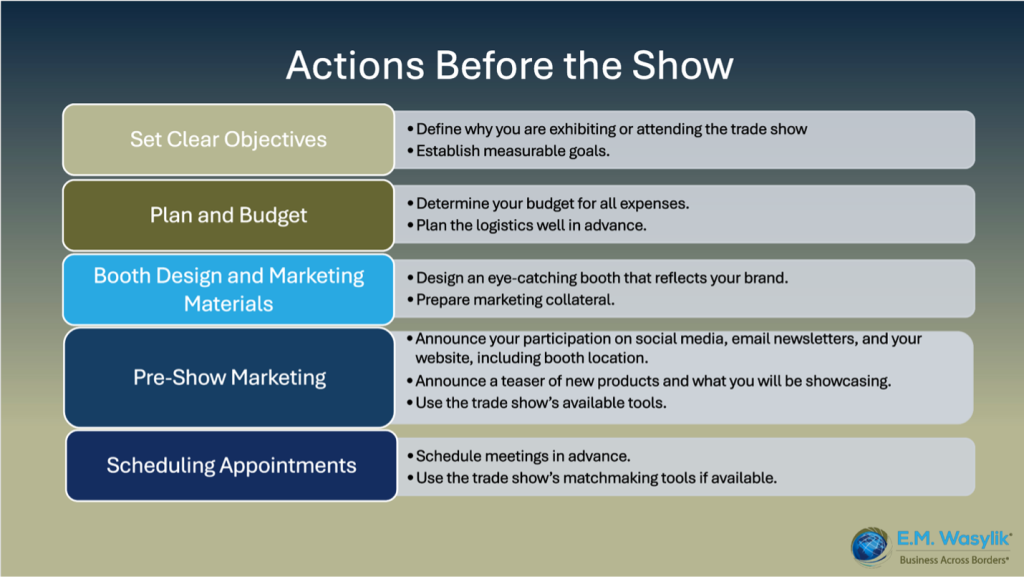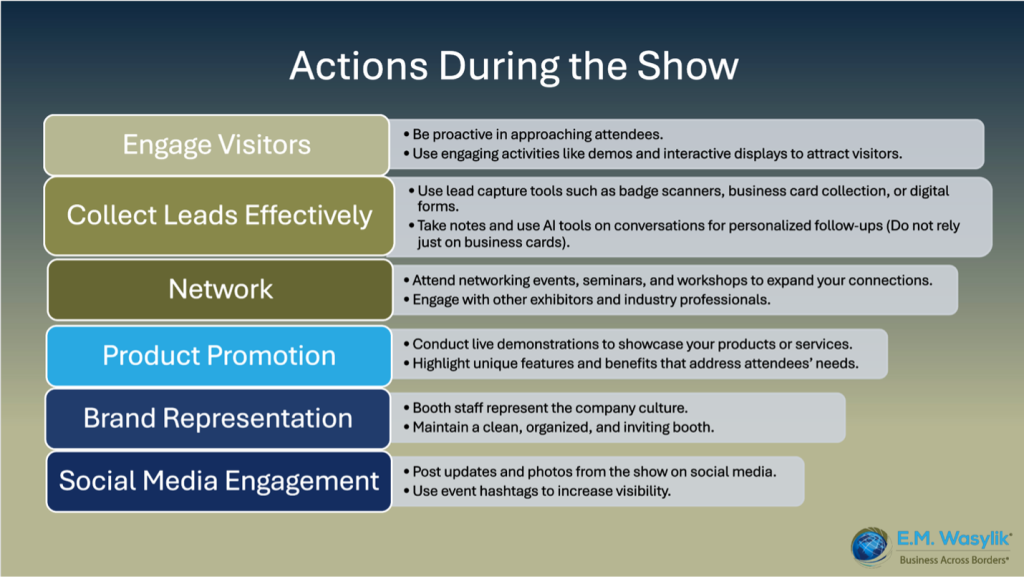In a recent roadshow hosted by the German American Chamber of Commerce – Midwest to promote Messe Hannover, a bi-annual trade show in Germany with over 4,000 exhibitors, E.M. Wasylik’s Managing Director, Ken Wasylik, was invited to speak on the how to ensure a strong return on the investment in a trade show. Watch the full presentation here!
Below are some of the key takeaways from each step of the process—before, during, and after the show.

Set Clear Objectives
Arguably the most important part of pre-show planning is knowing your Why. Who are you trying to reach? Why are you trying to reach them? How are you going to benefit them? If this trade show does not clearly provide answers to each of these questions, it may be more beneficial to just attend and walk the show for the first time and understand the landscape better. If you do have answers to these questions, ensure each decision there forth is made with the customer at the forefront.
Plan and Budget
Although a worthwhile investment when carried out properly, trade shows will add up the cost. Make sure everything is accounted for— booth construction, attractive graphics, show materials, samples, in-booth product / equipment, hotels, and food, and take extra care in adequately staffing the booth to speak to each visitor that comes along. As Ken says, “you never know if it’s going to be a good opportunity or a bad opportunity, but it’s an opportunity,” After the show, the CFO will nearly always ask, “was there a return on that?” As the answer is almost never immediate, track return and activity periodically throughout the year.
Booth Design and Marketing Materials
“Show halls are like what we call the horse stalls: one long line of booths where everyone sticks their heads out to the left, then to the right… Why would anyone stop at your booth?”
The halls at Hannover Messe can take 45 minutes to walk between. With thousands of exhibitors lined up, it’s essential to distinguish your booth in a memorable way. The graphics on the roll-up banners must be eye-catching, and care should be taken to place the product or collateral in an aesthetic, pleasing way. It is also important to consider that not everyone speaks English. Ensure your message gets across (and showcase your cultural competence) by providing product information and marketing collateral in the local language as well.
Pre-Show Marketing
At trade shows, it is common to find distributors from all across the globe, so no matter where prospects or current customers are located, don’t limit the communications to local contacts. Make sure to call and email everyone in advance and let them know that your company will be exhibiting including the booth location. Tell everyone.
Furthermore, if there are online tools in the show package available, use them to your advantage. These can be used for inviting people to the booth, as well as many other purposes.
Scheduling Appointments
“You’re talking to a prospect when your best dealer comes along. Who do you chat with?”
To avoid a scenario such as this, it’s important to try to schedule appointments in advance with existing and new contacts, as well as decide who on the team should take the meeting. Do your homework and find out who will be there, taking into consideration the location of each meeting and size of the exhibition grounds.

Engage Visitors
“You’re there! Be as active as you possibly can! Engage with as many people as you can.”
Attracting visitors can be accomplished in a variety of ways, from providing refreshments to interactive activities that allow them to engage in the booth. Product demonstrations are great for keeping prospects there long enough to pique interest and hold a conversation.
For example, at a recent fitness trade show, one stand invited visitors to see how many pullups they could muster in 20 seconds. This visitor engagement had a dual benefit. Influencers promoting their fitness & lifestyle brands flocked to the stand, live streaming the competition and expanding reach to hundreds of additional potential customers.
Collect Leads Effectively
The day of simply collecting the business card is gone, and so is scrambling at the end of the day (or admit it—the show) to remember key information. Utilizing AI tools, such as voice-to-text applications, can be hugely beneficial in keeping documentation of who came to the booth and what the follow-up should be. If this isn’t an option for you, opt for a notebook to write extensive notes and staple the business card to the page. The backside of the business card is oftentimes not large enough if you’re gathering all or the right information.
Another important variable to consider is consent to contact compliant with the European GDPR. While the specifics vary per show, consent is highly contingent on when and how you receive the information. Written in the fine print of some trade shows, the attendee’s consent is obtained when signing up for the entrance badge. This means that consent was automatically given when collecting email addresses through scanning the entrance badge. Collecting a business card during the show does not necessarily imply the same.
Network
If you’re located at a US pavilion, it’s likely that networking sessions are available the entire duration of the show, and when it comes it networking, it’s all about quantity. Meet as many people as possible, utilizing your phone (and those AI apps) to keep notes. Don’t just sit there and enjoy the beverages and hors d’oeuvres—engage, engage, engage!
Product Promotion
Engaging booth visitors isn’t for the means of engagement, but of promoting the product. If and when possible, use live demonstrations to make the product memorable. Showcase the production process or materials used by providing merchandise or other collateral, opting away from lower-impact items like company-branded pens or lanyards.
Brand Representation
In addition to product promotion, company promotion is equally valuable. People don’t know who you are – you need some kind of explanation. Showcase the company’s core values as part of the booth design. How are you different (better) from the competition?
Social Media Engagement
Similar to visitor engagement, social media can be an effective tool to show potential customers where you are located and who you are interacting with, providing the valuable element of human touch to marketing. Short clips or YouTube videos are an effective way to do this.

“The show’s over, you’re tired, your feet are aching, it’s time to go home…It was one great show, what should we do now?”
Prioritize Leads
Not all leads are of equal value at the same time; however, this does not mean that they one day will not be. Prioritize all into A, B, and C categories, with about 20% of the most actionable prospects in the A categories to focus the majority of your time—setting up meetings, phone calls, demos, etc. The B category should hold all those that are potential customers, without the urgency and certainty of an A lead. Sending product presentations and marketing collateral would be appropriate here. For C leads, a “nice to meet you” email suffices. While it might feel not worth the time to reach out to the latter group, what begins as a C lead Years 1, 2, and 3 might turn into a B lead in Year 4, and an A in Year 5.
Write a Comprehensive Post Show Report
Finally, something EMW has been commended on many times (and even something clients have adopted internally), is our standard offering of a comprehensive, post-show report. In this document, our associates lay out every detail of the show. In addition to lead prioritization, full profiles of each are written. Also included are detailed descriptions of the show: how it went, what went well, what could be improved upon, what the booth looked like, if the location was optimal, hotel, transportation, booth shipping logistics, etc, so that the next round can be an even greater success. This supporting document is of relevance in tracking ROI to the aforementioned CFO, as well.
On a practical note: Ken recommends staying at the location an extra day or two to complete follow-up and the show report, capitalizing on the opportunities before returning home and to business as usual.
For more tips on how to maximize your trade show ROI, get in touch with EM Wasylik!

